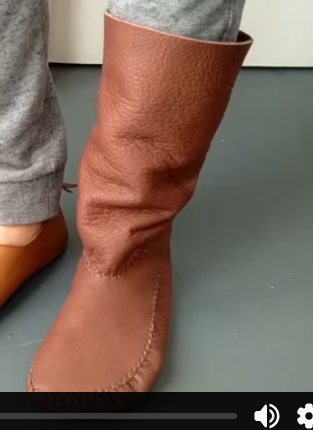-
Posts
1,283 -
Joined
Content Type
Profiles
Forums
Events
Blogs
Gallery
Everything posted by SUP
-
Wow!
-
The machine is more expensive. The $11 is for only one creaser tip.
-

Shopping cart security tokens
SUP replied to Klara's topic in Purses, Wallets, Belts and Miscellaneous Pocket Items
For such small items, I just stick on the spot shaped Velcro fasteners - hook and loop, I believe they are called. I use good glue though. The glue on these is abysmal. -
Thank you! A Merry Christmas and Happy New Year to you too! I hope the New year brings good health to you as well. And A Merry Christmas and Happy New Year to everybody.
-
You should find it here but will need to search for your specific bag tutorial. https://www.youtube.com/c/DieselpunkRo If the URL has changed, you could go to the email you would have received when you bought the pattern and reply there, asking for the url that you need.
-
Uttam asked whether I also said 'tongue firmly in cheek'. I said no, so he sent me to do so! He's a doll.
-
Makes sense. I guess so. I suppose I was comparing heavy belts to the heavy bag that I carry. However, I have tried putting everything into pockets and waist pouches and that is still heavy and uncomfortable. Maybe it is also a matter of what one gets used to using. Oh yes. They are nice. I just would not wear them though. I would worry about them slipping down. And women have wider hips, so belts usually remain in place. How on earth do men, with, presumably slim hips keep them up? Unless, ...ummmmm... the paunches help? (I beg the pardon of all the men out there who are slim).
-
@DieselTech I'll take your word for it. I agree about thin belts, although I wonder how thick leather, single layer will work? If the leather quality is good, will it not last longer and be lighter as well? I mean, people might just like lighter belts or might not be able to wear heavy ones due to issues like health - hip problems maybe?
-
@Dwight. I know what you mean. I feel the same about my bag too.
-
Oh Wow! @Dwight That makes it nearly 6 lb. that you carry around your waist, at a minimum. Isn't it exhausting? But I guess you are used to it. I know what to say next time anyone says my handbag is heavy. At least I can keep it down!
-
Thank you all for your replies. I have been pretty clueless, isn't it? Don't really notice these things, I guess. All I am used to is dress belts. So much to still learn. I don't want to even think of the weight of it all around your waists! Heavy belt, gun, with holster and whatever else! I mean pockets must hold wallet etc. as well? How much does it all end up weighing? Has anyone checked their weights before and after wearing it all?
-
I see people making gorgeous belts with really thick leather. I mean, 7-9oz, double layered! That would be up to nearly a cm thick! And so heavy too! Other than durability, is there any reason for such thick, heavy belts? Don't they weigh down on the waist? And then, add other stuff in pockets!. Wow! Rather than hold trousers up, I would worry that they will pull then lower. Just wondering.
-
Wow! That is beautiful!
-
DO you mean something like this but a little shorter? The foot part in these are a little impractical though. Diesel punk has some shoes that rise above the ankles. Those are not moccasins though. His directions are excellent as well. His moccasins are great too - I wear mine all the time. So maybe you could try making them, only taller. I fact, I have heard that he is very helpful. He might guide you on how to make them taller.
-

Can chrome tanned leather be dyed or vinegarooned?
SUP replied to redline's topic in Leatherwork Conversation
Even if the tea absorbs, will the tannins bind? Even after the iron acetates form, the color might bleed if damp or wet. I tried using tea once and that is what happened. Again, I might be wrong about this but my experience is that using tea and then vingaroon causes bleeding of the black color. Without the tea, it never bleeds because those tannins are bound to the leather, so there is nothing to bleed. -

Can chrome tanned leather be dyed or vinegarooned?
SUP replied to redline's topic in Leatherwork Conversation
@Northmount I was wondering. As there is no tannin in the leather in the first place, the tannins from tea might remain on the surface and interact with vinegaroon but bleed because there is nothing to hold it to the leather. Of course, I might be wrong about. -
After I skive, I gently sand it to even it out.
-
If the two layers are stuck together when curved, when the flap is straightened to open the bag, won't the outside crease?
-
Just ordinary saddle soap. You should get it in any leather store or on Amazon. I have no idea which country you are from, so cannot suggest a store
-
Have you tried cleaning it with saddle soap to get off the excess?
-
Ordinary veg tanned leather, dyed brown with Fiebing's Pro dye. Same as several other knife sheaths that I made at that time. I used the same vey tanned leather side from which to cut out the different sheaths. Made them the same way and dyed several of them different shades of brown - light, medium or dark. But other items have been dyed with the same brown as this sheath and they are not magnetic.
-
I would really like to know but I made the grave error of keeping the scissors and sheath 'very safely'. which means I now cannot find it anywhere. As a large roll of paper, similar kept safely, is not to be found either, my family does not hold out much hope for this much smaller item.



